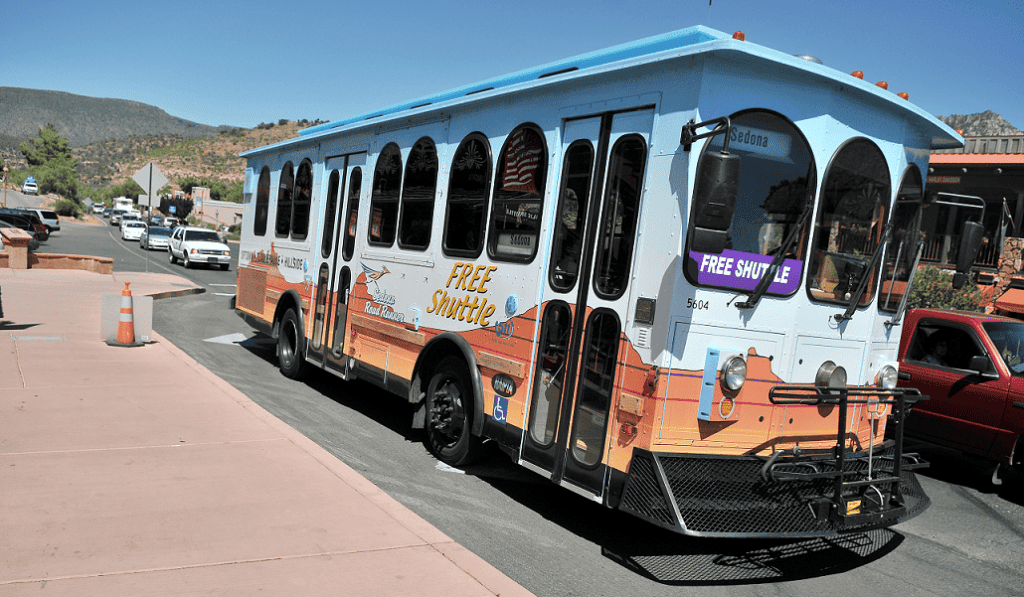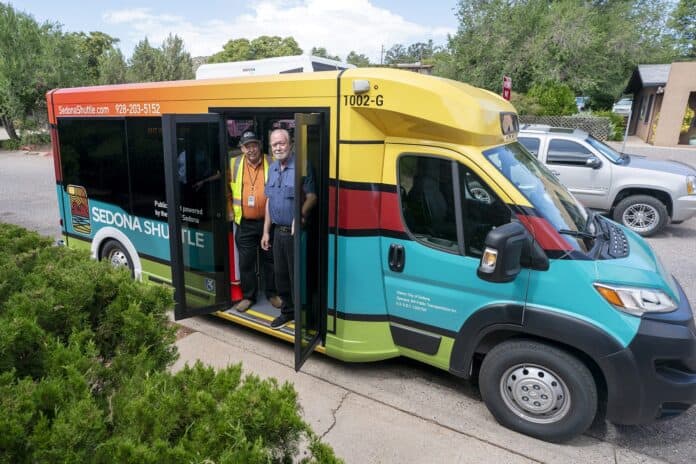Barring any last-minute delays after press time, the city of Sedona will officially be rolling out its new on-demand, curb-to-curb microtransit program on Thursday, Aug. 29, pun intended.
This service, first proposed back when Sandy Moriarty was still Sedona’s mayor, and formally presented in the 2020 Sedona Area Transit Implementation Plan, has long been delayed by funding and vehicle acquisition issues, notably back in summer 2022 when the vendor that was to supply the first shuttle buses ceased manufacturing them. The city had agreed to purchase them in December 2021 for rollout the following summer, two years ago now.
The most recent delay was caused by the city of Sedona waiting to acquire several federal grants to help pay for the transit system to make the vehicles Americans with Disabilities Act-compliant.
Public transit is unprofitable by design. The goal is to make government-owned public transit system more affordable than private sector options, like privately-owned taxis, shuttles or personal vehicles. As such, small governments often look for resources provided by larger governments to offset those initial costs or ongoing costs, or allocate tax funding to pay for ongoing operations and just accept the loss as the cost of providing transportation to users.

The Verde Shuttle, operated by the city of Cottonwood’s Cottonwood Area Transit program, is jointly funded by the cities of Sedona and Cottonwood.

It was formerly known as the Verde Lynx because all the buses run by the Northern Arizona Intergovernmental Public Transportation Authority had cute feline puns, like Flagstaff’s Mountain Line with a mountain lion graphic on the side.

The Verde Shuttle greatly benefits Sedona’s workforce, as workers in Cottonwood, Clarkdale and their satellite unincorporated areas can take a public bus into Sedona. The buses are largely used in the mornings, bringing workers into Sedona, and in the late afternoons and evenings, taking them back home. Over the years, we’ve had several employees at our newspaper regularly use the service.

Sedona previously had its own bus system, the Sedona RoadRunner, which operated from October 2006 to June 2011. That bus system had delays in starting, too, because council at the time decided not to go with the same kind of buses used in the rest of the NAIPTA network but instead, at the last minute, to buy more expensive trolleys. The trolleys were hard to repair, required specialty parts not interchangeable with those of the other buses and were garaged in Cottonwood, so they had to be driven into Sedona daily on the highway. The trolley route only ran from Uptown to Poco Diablo Resort, so they were useless for most Sedona residents, who live mainly in West Sedona, and were aimed at tourists. With low ridership, the purple-and-sky-blue shuttles died a slow death over several years.

The Sedona Trailhead Shuttle was launched in 2022, but it, as the name suggests, only runs from parking lots to trailheads. Also not helpful for residents who need public transit to go to work, stores or the doctor. The passenger numbers have been better than with the Sedona RoadRunner, but residents still have no public transit other than the Verde Shuttle along the state highways the bisect Sedona.
But after about five years of discussion and planning, the Sedona microtransit system is now set to launch later this week. We encourage residents to try it out. Download the TransLoc app and see if the microtransit system works as intended.
Click for TransLoc at the AppleStore or
TransLoc for Android and Google phones

Take some trips to stores, or to Uptown or go see a friend across town you would normally drive to visit. Take a microtransit shuttle to and from work one day. See how the app works and if it’s user-friendly. Sedona has an older population that stereotypically has some trouble with apps and digital devices, so see if you can manage the app and take a ride. We and other residents want to know if the city’s microtransit system, in the hands of actual users, operates as promised.

Once you’ve taken a few rides, write to us about your experiences. Did the shuttles arrive on time and as promptly as advertised? Did you get to and from your destinations with ease or difficulty? Did you enjoy not having to drive in Sedona’s traffic, or will you go back to driving your own vehicle? Did other users on your trip have any problems, or was their ride smooth? Was the $2 fee worth the effort? Would you recommend the shuttle service to others? Would you ride again?
Once you’ve considered your views, send them to us in a letter to the editor at editor@larsonnewspapers.com. Mention how many times you rode, approximately where you went and on which days you used the service.




















